Roundabout Sign Design Guidelines
City Guidelines Regarding the Installation of Signs at Roundabouts
Traffic Services Division of the Department of Public Works
Governing Document Reference:
Manual on Uniform Traffic Control Devices for Streets and Highways (MUTCD), 2009 or latest edition and Yield Sign Design Guidelines, Street Name Sign Design Guidelines, Object Marker Sign Design Guidelines, Keep Right Sign Design Guidelines and School Sign Design Guidelines.
MUTCD Requirements:
“Yield” Signs
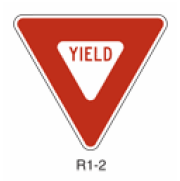
A “Yield” (R1-2) sign shall be used to assign right-of-way at the entrance to a roundabout. “Yield” signs at roundabouts shall be used to control the approach roadways and shall not be used to control the circulatory roadway. Other than for all of the approaches to a roundabout, “Yield” signs shall not be placed on all of the approaches to an intersection.
“Roundabout Directional Arrow” Signs
Where the central island of a roundabout allows for the installation of signs, “Roundabout Directional Arrow” (R6-4 or R6-4a) signs should be used in the central island to direct traffic counter-clockwise around the central island. “Roundabout Directional Arrow” signs shall be used only at roundabouts and other circular intersections.
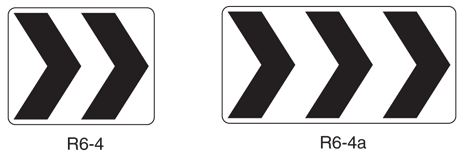
When used on the central island of a roundabout, the mounting height of a “Roundabout Directional Arrow” sign should be at least 4 feet, measured vertically from the bottom of the sign to the elevation of the near edge of the traveled way. More than one “Roundabout Directional Arrow” sign may be used facing high-speed approaches, facing approaches with limited visibility, or in other circumstances as determined by engineering judgment where increased sign visibility would be appropriate.
“Roundabout Circulation” Plaque
Where the central island of a roundabout does not provide a reasonable place to install a sign, “Roundabout Circulation” (R6-5P) plaques should be placed below the “Yield” signs on each approach. At roundabouts where “Roundabout Directional Arrow” signs and/or “One Way” signs have been installed in the central island, “Roundabout Circulation” plaques may be placed below the “Yield” signs on approaches to roundabouts to supplement the central island signs. The “Roundabout Circulation” plaque may be used at any type of circular intersection.
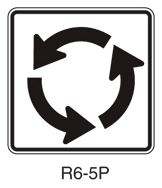
“Intersection Lane Use Control” Signs for Roundabouts
“Intersection Lane Control” signs, if used, shall require road users in certain lanes to turn, shall permit turns from a lane where such turns would otherwise not be permitted, shall require a road user to stay in the same lane and proceed straight through an intersection, or shall indicate permitted movements from a lane.
At roundabouts, “Intersection Lane Control” (R3-5, R3-6, and R3-8 series) signs may display any of the arrow symbol options shown below.
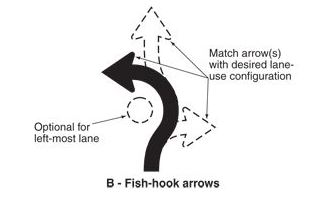
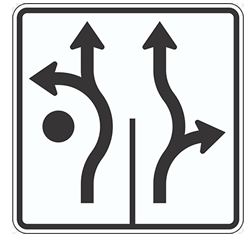
The sign shall indicate only the single vehicle movement that is required from the lane and shall be located in advance of the intersection, such as near the upstream end of the mandatory movement lane, and/or at the intersection where the regulation applies.
“Pedestrian Crossing” Signs “Pedestrian Crossing” (W11-2) signs may be used to alert road users in advance of locations where unexpected pedestrian entries into the roadway might occur or where shared use of the roadway by pedestrians might occur. These conflicts may be relatively confined, or might occur randomly over a segment of roadway.
If a post-mounted sign is placed at the location of the crossing point where pedestrians might be crossing the roadway, a diagonal downward pointing arrow (W16-7P) plaque shall be mounted below the sign.
“School Crossing” Signs See School Crossing Sign Design Guidelines City Guidelines for the Installation of School Crossing Signs.
“Circular Intersection Symbol” Signs “Circular Intersection Symbol” (W2-6) signs may be installed in advance of a circular intersection. If an approach to a roundabout has a statutory or posted speed limit of 40 mph or higher, the “Circular Intersection Symbol” (W2-6) sign should be installed in advance of the circular intersection.
“Advisory Speed” Plaque The “Advisory Speed” (W13-1) plaque may be used to supplement any warning sign to indicate the advisory speed for a condition.
City of Overland Park Guidelines for Installation:
"Yield" Signs “Yield” (R1-2) signs should be installed on the right hand side of the intersection approach. Yield signs are not required in the splitter islands on the left hand side of the approach except for multi-lane roundabouts. For multi-lane roundabouts, an additional yield sign will also be installed in the splitter island on the left hand side of the approach.
• “Street Name” (D3-1) signs should be installed above the yield signs located on the right hand side of the intersection approach and should consist of double sign blades for each street name mounted back to back.
• “Roundabout Directional Arrow” (R6-4 or R6-4a) signs should be installed within the central island of the roundabout directly in front of the approach lane. The sign should consist of two or three black chevrons on white background. The R6-4 sign should be used for single lane roundabouts and the R6-4a sign should be used for two-lane roundabouts.
Where the central island of a roundabout does not provide a reasonable place to install a sign, Roundabout Circulation (R6-5P) plaques should be placed below the yield signs on each approach.
• “Pedestrian Crossing” (W11-2) signs or “School Crossing” (S1-1) signs should be installed as appropriate at crosswalks within the limits of a roundabout. The decision to install these signs should be based on the expected volume of pedestrian traffic (minimum of 10 pedestrians per hour for any one hour of the day) and in consideration of established signed and marked school crossing locations. The signs should be installed both at the approach and departure points near the crosswalk location.
• “Downward Diagonal Arrow” (W16-7) signs should accompany the “Pedestrian Crossing” (W11-2) signs or the “School Crossing” (S1-1) signs.
• “Circular Intersection” (W2-6) signs should be installed in advance of the roundabout on each approach with an “Advisory Speed Plaque” (W13-1) sign.
• “Advisory Speed Plaque” (W13-1) signs should be installed below the “Circular Intersection” (W2-6) sign with the appropriate advisory speed.
• “Lane Use” (R8-3 “Special”) signs should be installed in advance of multi-lane roundabouts to indicate the allowable turning movements from each lane of the roundabout.
• “One-Way” (R6-1) signs are not required within the central island of the roundabout.
• “Type I Object Marker” (OM1-3) signs are not required to be installed on the approach or departure noses of splitter islands.
• “Keep Right” (R4-7) signs are not required to be installed on the approach or departure noses of splitter islands.
Sign Standards: Yield Sign The standard size of the “Yield” (R1-2) sign will be 36” x 36” x 36” when facing traffic on a single lane approach and 48” x 48” x 48” when facing traffic on a multi-lane approach. It shall be a downward-pointing equilateral triangle with a wide red border and the legend YIELD in red on a white retro-reflectorized background.
Street Name Sign The standard size for “Street Name” (D3-1” signs will be as indicated in the